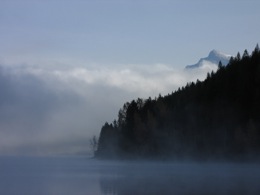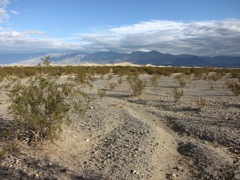As the world warms, officials at the National Park Service are starting to sweat: No glaciers at Glacier, no Joshua trees at Joshua Tree. These are part of the long-range forecast for the national parks.

Last month, in a post from Glacier National Park, I noted that Park Service director Jon Jarvis was not in a mood to mince words, calling climate change “the greatest threat to the integrity of the national park system that we’ve ever faced.”
That assertion was underscored last week in a new report on potential impacts to the parks from climate change. The collaboration by the Natural Resources Defense Council and the Rocky Mountain Climate Organization, attempted to zoom in on specific parks and projected changes ahead for ten national parks in California, as well as impacts on the state’s economy.

Some conclusions under a “medium-to-high” emissions scenario, toward the end of this century: Higher temperatures in Joshua Tree National Park would mean the end of, well, Joshua trees in the park. Muir Woods could be as warm, on average, as San Diego has been historically, making it less hospitable to the park’s legendary coast redwoods. Death Valley, already the hottest spot on the continent, could become virtually uninhabitable during the summer, as average temperatures rise by more than eight degrees, Fahrenheit, over average readings from 1961 to 1990.
And of course, for Montana’s Glacier National Park, the report’s authors cite projections that the last of the park’s glaciers will be gone within 20 years, if not sooner.
This is, perhaps, a good place to pass along a favorite mantra of park rangers of late; that Glacier park wasn’t actually named for its glaciers, but for the geologic history that formed the region’s spectacular features. But it’s logical that Glacier, tucked into the northwestern corner of Montana, has become the “poster child” of climate change in the national parks. Scientists estimate that its 25 remaining glaciers could well be gone in a dozen years or so. Superintendent Chas Cartwright conceded that may be a small part of why Glacier is seeing record numbers of visitors — more than two million this year, which is the park’s centennial.
“Glacier isn’t the only place we’re seeing direct effects from climate change on the ground, right now,” Jarvis said, standing on a gravel bar in McDonald Creek. The parks chief cited apparent climate effects throughout the park system, including receding glaciers, withering water content in the mountain snowpack, and rain-on-snow events shifting from spring to fall. “That completely changes the system,” said Jarvis, who said they’re also seeing wildland fires burning an average of 20 days longer into the season, encroachment of more exotic plants, and species moving up in elevation or vanishing from the landscape entirely. “We’re not just gonna sit around and not do anything about it.”
The question is what to do about it, which presents some unprecedented dilemmas for park managers and scientists, which, Jarvis says, are “causing us to rethink even the fundamental principles of national parks.” Where as in years past, for example, new species moving into a park were looked upon as invaders to be dealt with inhospitably, now “they may be coming in because this is their last refuge.”
Accommodating migrating species is one thing. But also on the table is direct, possibly radical intervention to save others. Jarvis recounts the time when a park scientist asked him, sardonically, “When do you put a sprinkler system on the giant sequoias?” Jarvis asks rhetorically, “Where is the next habitat for the giant sequoia and are we as a society willing to move them, or plant them (somewhere else)? “The biggest step in climate change is starting to ask those kinds of questions and to bring the very best minds to help us begin to wrestle with those as a society.”
To this end, Jarvis is advancing a strategy with four key components:
– Expand the science and develop long-term data sets
– Embrace adaptation and multiple-scenario planning “at the landscape scale”
– Continue mitigation efforts, reducing the carbon footprint of the parks themselves
– Communication, leveraging the “extraordinary bully pulpit” that the parks provide, training scientists to speak to the layman, seizing opportunities to talk to the public about climate change.

Jack Potter, who directs science at Glacier, reinforced that this isn’t just tomorrow’s problem. He noted that spring “green-up” is occurring about three weeks ahead of the 40-year average at Glacier, which means that the landscape is drying out sooner in the season. “No matter what scenario you look at, it’s going to be drier,” said Potter, pointing toward distant mountain snowfields. “That has all kinds of cascading effects downstream.”
Potter said park managers are being forced to re-examine “the role of parks as reservoirs for biodiversity” and “how we view the type of appropriate management…in the face of the possible scenarios that are out there relating to climate.”
To read about another challenge facing the parks, see Lauren Sommer’s story on air pollution impacts at Yosemite.
